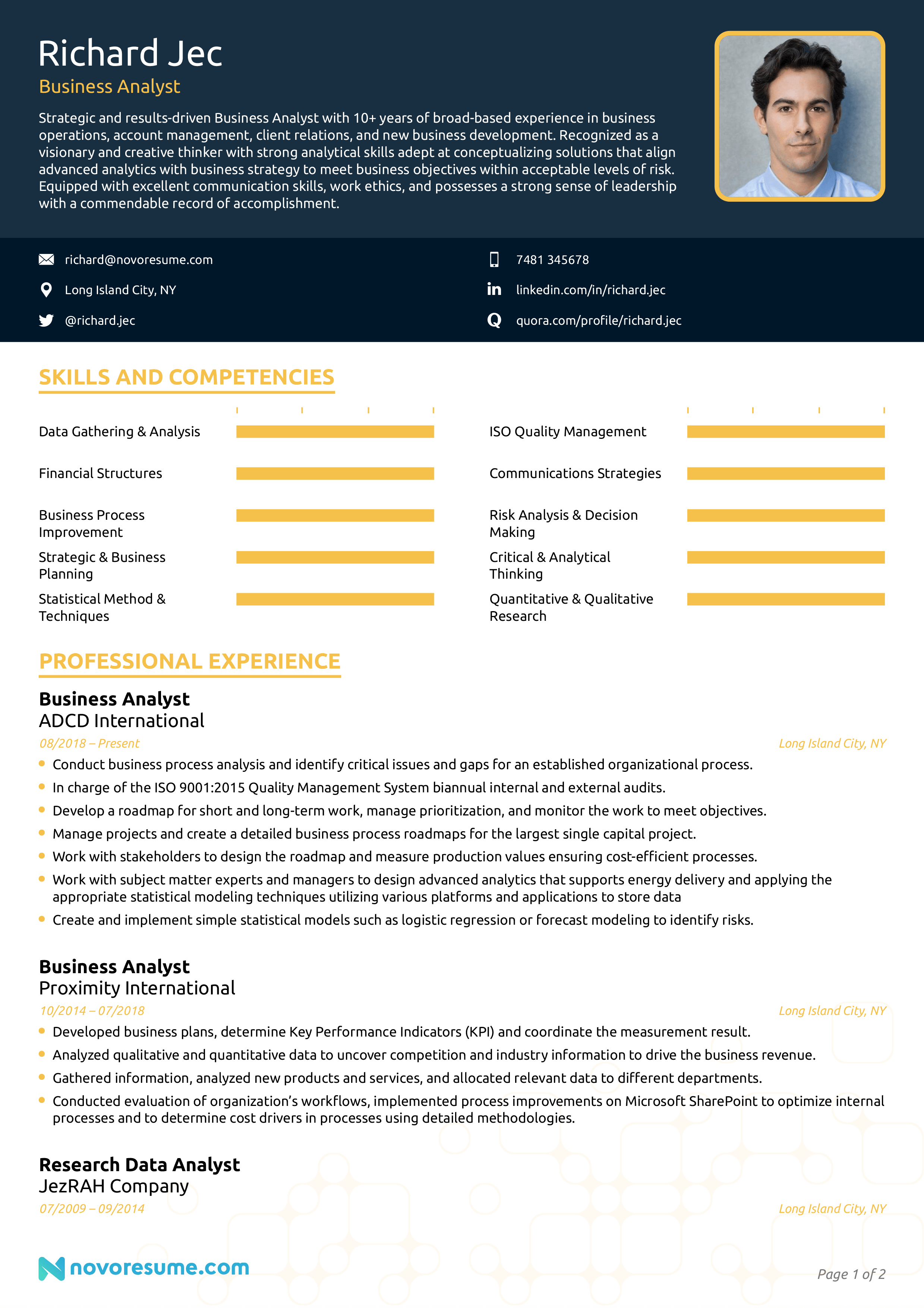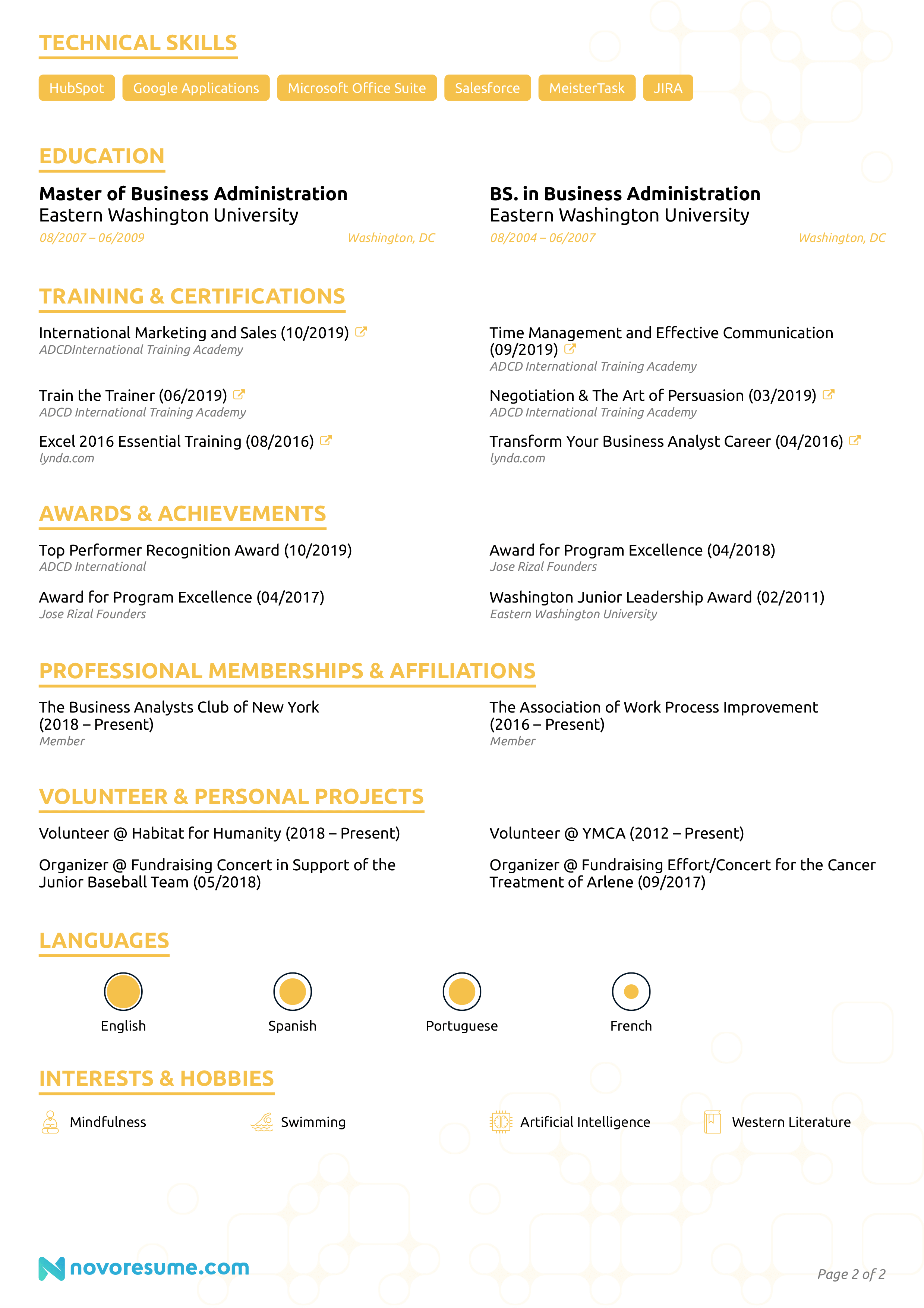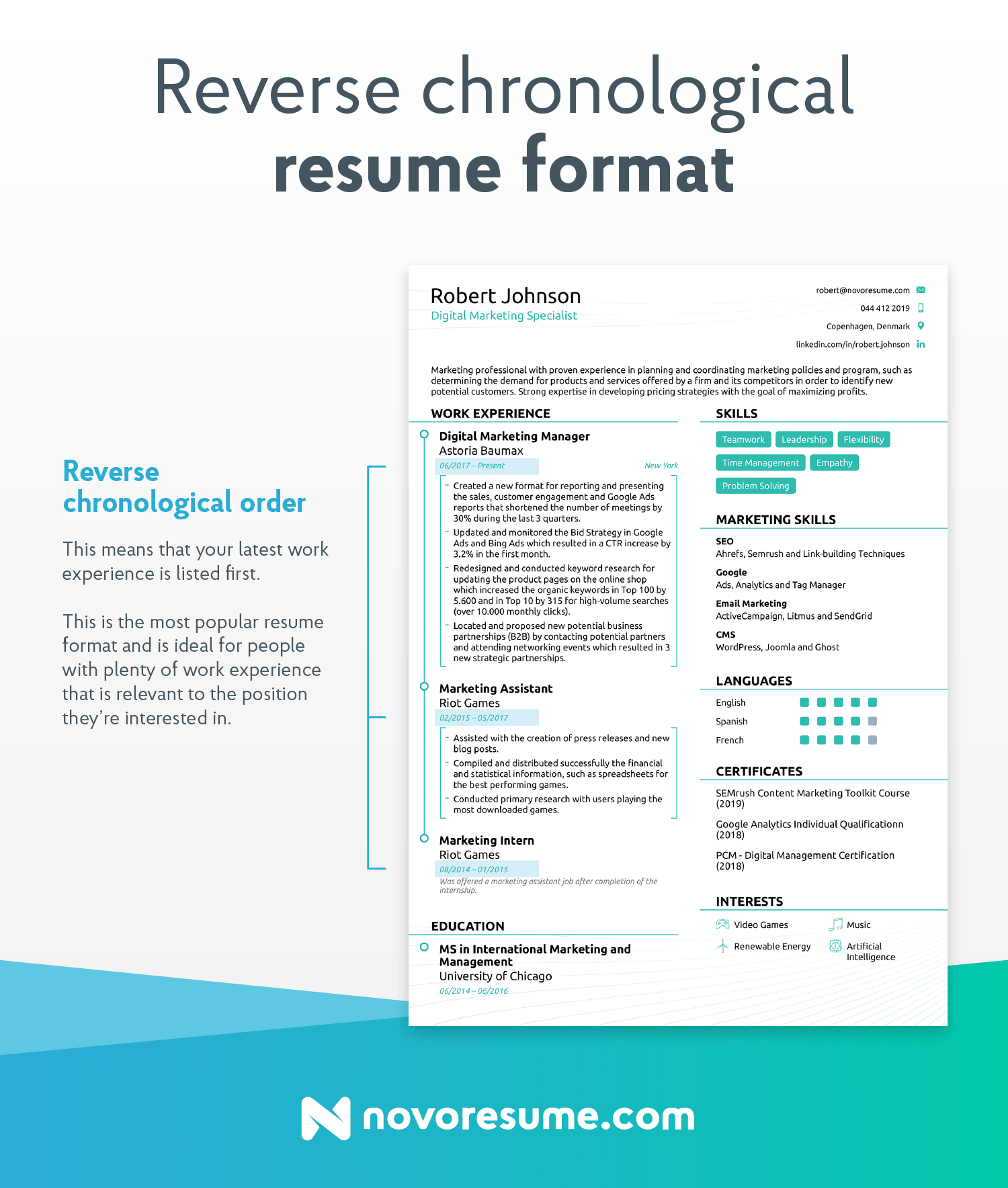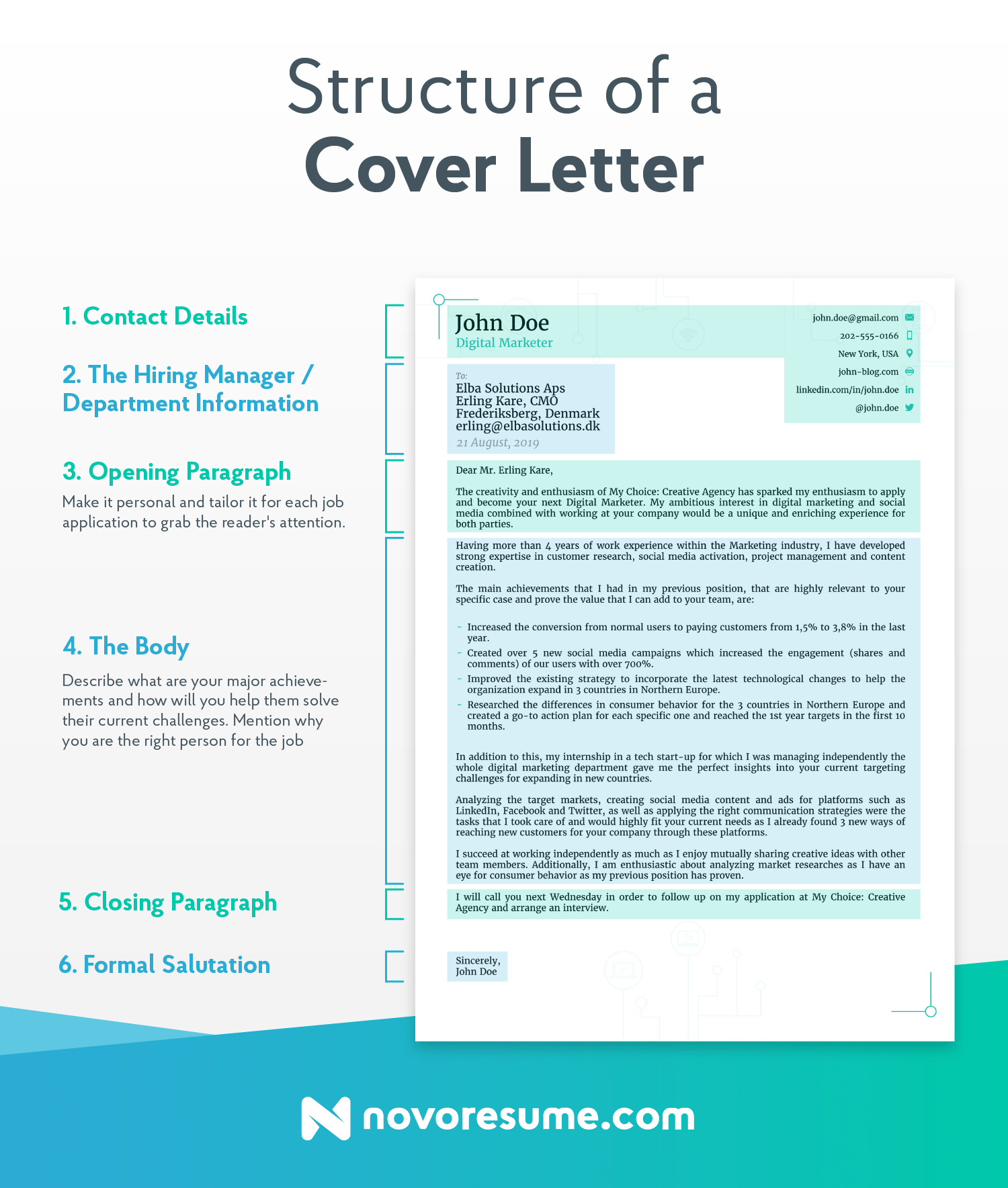You’re a business analyst.
You use your analytical skills to help businesses you want to grow.
But when it comes to creating a winning resume, you’re the one who needs help.
How do you make a business analyst resume, anyway?
Surely it’s the same for every professional, right?
We understand you have many questions.
Fortunately, we built this step-by-step guide to help you land that dream role!
- An example of a finished business analyst resume that works
- How to write a business analyst resume that’ll fill up your interview diary
- How to make your business analyst resume stand out [with top tips & tricks]
Before we get into the details, here’s a business analyst resume example, created with our very own resume builder:


Looks ace, doesn’t it?!
Follow the steps below to create a business analyst resume that gets results, just like the above example.
Looking for a resume example for a different position in the business field? Check out our related resume examples:
- Financial Analyst Resume
- Accountant Resume
- Bookkeeper Resume
- Bank Teller Resume
- Banking Resume
- MBA Resume
- Executive Assistant Resume
- Consultant Resume
- Administrative Assistant Resume
- Office Assistant Resume
- Career Change Resume
How to Format a Business Analyst Resume
Before you can impress the hiring manager with your array of skills and experiences, you need to pick the most appropriate format.
You see, the correct format allows your best features to be seen easily by the hiring manager.
Anyway, you won’t be getting hired if you have a messy resume!
The most common resume format is “reverse-chronological,” and it’s for good reason. This starts with your most recent work experience, and then works backward. As such, it’s perfect for those who want to show their career progression.

The following resume formats also get our approval:
- Functional Resume – Skills stronger than your work history? Have gaps in your employment history? Use a functional format that focuses on your skills.
- Combination Resume – Got skills AND business experience? Use a combination format that combines both “Functional” and “Reverse-Chronological” formats
Once you’ve chosen an appropriate format, you need to nail-down your resume layout.
To keep your resume professional, we recommend:
- Margins - Margins of one-inch on all sides
- Font - Pick a unique, yet professional font
- Font Size - Use a font size of 11-12pt for normal text and 14-16pt for headers
- Line Spacing - Use 1.0 or 1.15 line spacing
- Resume Length - Don’t go over the 1-page limit. For guidance, view these one-page resume templates
Use a Business Analyst Resume Template
Word is great for writing simple documents.
But for creating a professional-looking resume…think again!
You see, Word isn’t the best for building files that rely on strict formatting.
Want to skip the formatting issues? Use a business analyst resume template.
What to Include in a Business Analyst Resume
The main sections in a business analyst resume are:
- Work Experience
- Contact Information
- Skills
- Education
Want to go a step further? You can also add these optional sections:
- Awards & Certification
- Languages
- Interests & Hobbies
Great stuff! Now what goes under each of these sections? Read on to learn how.
Want to know more about resume sections? View our guide on What to Put on a Resume.
How to Correctly Display your Contact Information
Now, there’s no need to complicate this section, just keep everything factually correct.
The contact information section must include:
- Full Name
- Title - In this case, “Business Analyst”
- Phone Number – Check this for errors. Any mistake will prove costly
- Email Address - Use a professional email address (firstname.lastname@gmail.com), not one from your younger days (nicolalikesrabbits@gmail.com).
- (Optional) Location - Applying for a business analyst job abroad? Mention your location.
- Nicola Jenkins - Business Analyst. 101-358-6095. njenkins@gmail.com
- Nicola Jenkins, Business Queen. 101-358-6095. nickyistricky@gmail.com
How to Write a Business Analyst Resume Summary or Objective
It’s safe to say that recruiter’s don’t have time to analyze every resume.
Instead, they glance over them, while looking for the main points.
In fact, studies have shown that recruiters spend less than 6 seconds on each resume!
So, what can you do?
You need to an opening paragraph that makes your value clear to see.
To do this, use a resume summary or objective.
These are both short, snappy sections that go on top of your resume, just under your contact information.
Now, we cannot understate the importance of this section. It really could be the deciding factor between scoring an interview for a business analyst position and simply having your resume dismissed.
But how do the two differ?
A resume summary is a captivating overview of your professional experiences and achievements.
- Senior Business Analyst with seven years experience in developing award-winning strategies for a large e-commerce retailer. Most notable achievements include saving the company $2M annually and boosting revenue by 23% in 2017. Have a Business Management B.A. Seeking to leverage my interpersonal analytical skills to improve business at Software YXZ.
A resume objective is short snapshot of your professional goals.
- Motivated Program Manager looking to transition to the new business analyst at Company XYZ. Passionate about analyzing service and product lines to maximize revenue. Have a B.A in Business Management. Skilled financial analysis, risk analysis, and pay great attention to detail.
So, which one should an analyst use, summary or objective?
Generally, business analysts with relevant work experience should choose a resume summary. A resume objective is suited to analyst-hopefuls that have the skills, but lack the relevant experience (career changers, graduates, or those still studying).
- The recruiter wants to see what hiring you does for them, not what it will do for your career. Use this section to focus on how your abilities will benefit the company.
How to Make Your Business Analyst Work Experience Stand Out
Recruiters hate one thing:
Risk!
You see, they need to know that you’ll be able to do a good job.
The last thing they want is to be forced to replace you in two months time!
And the easiest way to impress the recruiter is with your work experience.
There’s no doubt that this is the most important section of your resume, as a well-written work experience section reveals your most notable successes and what you are capable of achieving.
Here’s the best way to structure your work experience section:
- Position name
- Company Name
- Dates
- Responsibilities & Achievements
Business Analyst
XYZdigital
02/2016 – 03/2020
- Completed initial in-depth analysis – boosting revenue by 23% in the first year.
- Improved customer service portal – reducing refunds by 12%.
- Improved operations to save the company $2 million annually.
For a resume that stands out from the competition, make sure to focus on your most notable achievements, not your daily tasks.
Instead of saying:
“Customer service optimization”
Say:
“Improved the customer service portal – reducing refunds by 12%”
Simply put, the first statement is too generic. How many times do you think the recruiter has read these same exact words?
The second statement gets stuck into the finer details! It shows you saved the company money, and are a valuable asset to the company.
- Quantifying your analyst experience shows that you’re meticulous and pay great attention to detail, which is a highly-desirable attribute to all businesses.
What if You Don’t Have Work Experience?
Maybe you’re a business graduate looking for your first business analyst job?
Or maybe you have experience in business, but never as an analyst?
Recruiters want employees that they can rely on.
But whether you have job experience or not, there are options.
You see, it doesn’t matter if you’ve never held the job title of “business analyst”, as you can call-upon the crossover skills from previous jobs.
For example, if you’ve worked in accounting, you can talk about any crossover skills and experiences. Just like a business analyst, you would need to be analytical and pay great attention to detail.
Furthermore, research from the Bureau of Labor Statistics shows that business analyst positions are likely to grow 19% by the year 2024. With this fact in mind, be sure to pursue a journey down the “business analyst” highway!
For the students reading this, you’ll enjoy our guide on how to make a student resume!
Use Action Words to Make Your Business Analyst Resume POP!
- “Made”
- “Managed”
- “Worked”
…are examples of the generic words the recruiter is tired of seeing.
However, you want to separate your resume from the competition, which means using power words to make your achievements stand out:
- Conceptualized
- Initiated
- Spearheaded
- Determined
- Formulated
How to Correctly List your Education
Next up, you need to list your education history.
There are no magic secrets with this section, just list your education history in the follow format:
- Degree Type & Major
- University Name
- Years Studied
- GPA, Honours, Courses, and anything else you might want to add
B.A. in Business Management
Chicago State University
2015-2018
- Relevant Courses: Operations & Digital Business, Decision Making, Accounting and Finance Fundamentals, Analysing and Managing Information, Global Business Environment, Global Strategic Management, Innovation and Creativity
- GPA: 3.8
Now, before you move on, let’ answer some of the most frequent questions that we get:
- What if I’m still in education?
Regardless of your current situation, you should mention all years of education to date.
- Should I list my high school education?
Generally, only list your highest form of education. If that’s from your high school, then go for it.
- Should education be listed before experience?
No, education should be listed AFTER experience.
Need more advice? Check out our guide on how to list education on a resume.
Top 17 Skills for a Business Analyst Resume
As the hiring manager is scanning down your resume, what do you think they are looking for?
Well, that you have the required skills for the job.
Remember, the hiring manager doesn’t know how amazing you are, so you need to tell them!
Even the world’s best business analyst will get rejected if their skills aren’t clear to see.
Here are some of the most common business analyst skills:
Hard Skills:
- As-In Analysis
- Benchmarking
- Gap Analysis
- Analytical Software
- Financial Analysis
- Risk Analysis
- SWOT Analysis
- Wireframing
- Defining scope
Soft Skills:
- Creative Thinking
- Communication
- Research
- Time Management
- Team Player
- Public Speaking
- Attention to Detail
- Organization
- Generally, include only the most important soft skills. You see, the hiring manager sees the same generic soft skills on EVERY resume. Any graduate can claim they have communication skills, but not many can correctly conduct SWOT analysis.
Here’s a more comprehensive list of 150+ must-have skills this year.
What Else Can You Include?
We’ve now given a breakdown of every essential resume section.
So, time to call it a day, right?!
Not quite.
Having great education and experience sections should be enough to get you shortlisted, but who knows if that’s enough to stand out from the competition?
If you don’t want to risk leaving things to chance, you can add these following sections:
Awards & Certifications
Have you been recognised for your commitment to business?
Have you completed any third-party marketing courses?
Got any awards to be proud of?
Definitely add them to your resume!
Here’s an example:
Awards & Certificates
- “Critical Thinking Masterclass” - MadeUpUniversity
- “Learning How to Learn” - Coursera
- “Excel to MySQL: Analytic Techniques” - Coursera
Languages
Even though it is very unlikely that you’ll be required to speak a second language, it’s still an impressive ability.
As such, feel free to add a language section to your resume, but only if you have space.
Rank the languages by proficiency:
- Native
- Fluent
- Proficient
- Intermediate
- Basic
Interests & Hobbies
Now, you may be wondering, “why on earth does the hiring manager need to know about my weekend art classes?”
Well, your hobbies reveal the person behind the qualifications.
Banking teams want a banker that will be pleasant to work with.
And the best way to do this is by showing your hobbies and interests, especially if you enjoy social activities.
Here’s which hobbies & interests you may want to mention.
Include a Cover Letter with Your Resume
You should now have finished a first-class resume that’ll land interviews.
But is this enough?
And is this a risk you can take?
You see, cover letters are an important part of the hiring process.
They show the hiring manager that you have a desire to work for their company.
To create a winning cover letter, we must ensure that it is structured correctly.
Here’s how to do that:

Make sure your cover letter includes the following sections:
Personal Contact Information
Your full name, profession, email, phone number, and current location
Hiring Manager’s Contact Information
Their full name, position, location, email
Opening Paragraph
It’s no secret that recruiter’s skim through applications. As such, you need to hook the reader within the opening paragraph. Use concise language to mention…
- The exact position you’re applying for
- Your summary of your experience and best achievement to date
The Body
After the introduction, it’s time to get deeper into the following specifics:
- Why you want to work for this specific company
- What you know about the company’s values and goals
- How your top skills are relevant to the job
- Which other similar positions have you held before
Closing Paragraph
Finish the letter professionally and friendly. You should:
- Conclude the main points from the body paragraph
- Thank the recruiter for their time and for the opportunity
- End with a call to action that asks to continue the conversation. For example, “At your most convenient opportunity, I’d love to discuss more about how I can help Company XYZ with X”.
Formal Salutations
Finally, sign off the letter in a professional manner. Something like, “Kind regards” or “Sincerely”.
For ultimate inspiration, read our step-by-step guide on how to write a cover letter.
Key Takeaways
Get ready.
If you followed the advice in this guide, you’re about to be invited to a lot of interviews.
Let’s quickly summarize what we’ve learned:
- Format your business analyst resume correctly. Start with the reverse-chronological format, and then follow the best content layout practice
- Use a resume summary or objective to steal the reader’s attention
- In the work experience section, you should highlight your achievements, rather than your daily duties
- Use a convincing cover letter for an application that stands out


